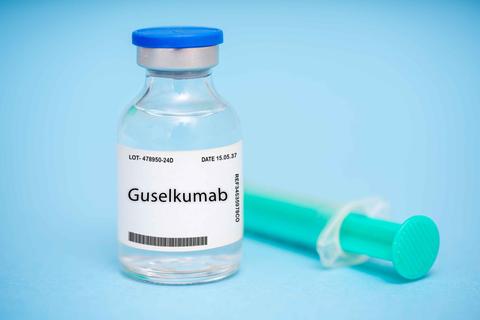Therapy with the IL-23 antibody guselkumab for Crohn’s disease
Panaccione R et al, Lancet. 2025;406(10501):358-375
Intravenous induction followed by subcutaneous maintenance therapy with guselkumab was efficacious in participants with moderately to severely active Crohn's disease in two independent phase 3 trials (GALAXI-2 and GALAXI-3), showing superiority to placebo and ustekinumab at week 48 across multiple endpoints.
Background: Despite the availability of biological therapies, suboptimal disease control remains a problem for patients with Crohn's disease. The authors report the results of the GALAXI-2 and GALAXI-3 studies, which aimed to assess the efficacy and safety of intravenous induction followed by subcutaneous maintenance therapy with guselkumab over 48 weeks in adults with moderately to severely active Crohn's disease.
Methods: GALAXI-2 and GALAXI-3 were identically designed, phase 3, randomised, double-blind, triple-dummy, treat-through trials with active and placebo comparators. Adult patients with moderately to severely active Crohn's disease (≥ 3 months duration) were enrolled at 257 sites across 40 countries. Eligible participants were randomly assigned (2:2:2:1) by use of a centralised computer-generated schedule to one of four treatment groups: (1) 200 mg intravenous guselkumab at weeks 0, 4, and 8, then 200 mg subcutaneous guselkumab every 4 weeks from week 12 to week 44 (guselkumab 200 mg group); (2) 200 mg intravenous guselkumab at weeks 0, 4, and 8, then 100 mg subcutaneous guselkumab every 8 weeks from week 16 to week 40 (guselkumab 100 mg group); (3) approximately 6 mg/kg intravenous ustekinumab at week 0, then 90 mg subcutaneous ustekinumab every 8 weeks from week 8 to week 40 (ustekinumab group); or (4) intravenous placebo every 4 weeks at weeks 0, 4, and 8 (placebo group). At week 12, participants without a clinical response to placebo received masked rescue therapy with ustekinumab; all other participants remained on their randomised regimen irrespective of response status at week 12. Participants, investigators, site personnel, and the funder were masked to study treatment until all participants had either completed the follow-up visit at week 48 or terminated study participation before week 48. Coprimary composite endpoints (comparing each guselkumab regimen with placebo) were (1) clinical response at week 12 and clinical remission at week 48 and (2) clinical response at week 12 and endoscopic response at week 48, measured in the primary analysis population of all randomly assigned participants who received at least one dose of the study agent and satisfied the Simple Endoscopic Score for Crohn's Disease (SES-CD) eligibility criteria introduced with the third protocol amendment as per health authority request. Safety was assessed in participants who received at least one dose of study treatment (all-treated analysis population).

Findings: From January 8, 2020, to October 20, 2023, 1048 participants were randomly assigned, treated, and followed up until week 48, of whom 1021 participants were included in the primary analysis population: 508 (49.8%) in GALAXI-2 and 513 (50.2%) in GALAXI-3. Both guselkumab regimens were superior to placebo for the endpoint of clinical response at week 12 and clinical remission at week 48 in GALAXI-2, which was observed in 80 of 146 (55%) participants in the guselkumab 200 mg group, 70 of 143 (49%) in the guselkumab 100 mg group, and nine of 76 (12%) in the placebo group (adjusted treatment difference 43% [95% confidence interval [CI]: 32–54] in the guselkumab 200 mg group and 38% [27–49] in the guselkumab 100 mg group; p < 0.0001), and in GALAXI-3, observed in 72 of 150 (48%) participants in the guselkumab 200 mg group, 67 of 143 (47%) in the guselkumab 100 mg group, and nine of 72 (13%) in the placebo group (35% [24–46] and 34% [23–45]; p < 0.0001). Similarly, both guselkumab regimens were superior to placebo for the endpoint of clinical response at week 12 and endoscopic response at week 48 in GALAXI-2, observed in 56 (38%) participants in the guselkumab 200 mg group, 56 (39%) in the guselkumab 100 mg group, and four (5%) in the placebo group (33% [24–42] in the guselkumab 200 mg group and 34% [24–43] in the guselkumab 100 mg group; p < 0.0001), and in GALAXI-3, observed in 54 (36%) participants in the guselkumab 200 mg group, 48 (34%) in the guselkumab 100 mg group, and four (6%) in the placebo group (31% [21-40] and 28% [19–37]; p < 0.0001). Serious adverse events occurred in 21 (7%) participants in the guselkumab 200 mg group (incidence rate 9.7 events per 100 participant-years), 32 (11%) in the guselkumab 100 mg group (14.9 events per 100 participant-years), 35 (12%) in the ustekinumab group (18.4 events per 100 participant-years), and 23 (15%) in the placebo group (23.8 events per 100 participant-years). No deaths were reported.
Interpretation: Intravenous induction followed by subcutaneous maintenance therapy with guselkumab was efficacious in participants with moderately to severely active Crohn's disease, showing superiority to placebo and ustekinumab at week 48 across multiple endpoints. Safety outcomes were favourable and consistent with the known profile of guselkumab in approved indications.